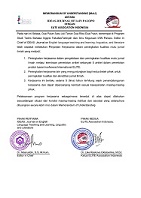An Analysis of Directive Acts Found in “The Princess Switch†Movie
DOI:
https://doi.org/10.24256/ideas.v11i1.3718Keywords:
directive acts, speech acts, pragmatics.Abstract
The aim of this descriptive qualitative research was to examine the various types of directive uttered by the characters in The Princess Switch movie. The data were collected from the characters' utterances of directive acts in the movie. The theory proposed Searle (1979) was used to analyze the types of directive acts. The observational method and non-participatory technique were employed to obtain the data. In addition, the data were evaluated using the pragmatic identity method and pragmatic competence- in equalizing technique. The results demonstrated that the characters in The Princess Switch movie delivered 20 utterances of directive acts. There were 9 data displayed asking, 3 data displayed requesting, 1 data displayed inviting, 3 data displayed advising, 3 data displayed permitting, and 1 data displayed commanding. The asking type of directive acts was the most common type as the characters in the Princess Switch regularly asking each other questions.
Â
References
Biatrik, D., Natsir, M., & Kuncara, S. D. (2020). The functions of directive speech acts of Maleficent character in Maleficent movie. Jurnal Bahasa, Sastra, Seni, Dan Budaya, 4(3), 460–475. https://journals.unmul.ac.id/index.php/JBSSB/article/view/2869
Della, F., & Sembiring, B. (2018). An analysis of directive speech acts by Searle theory in “Sleeping Beauty†movie script. Journal of English Education and Teaching, 2(1), 22–27. https://doi.org/10.33369/jeet.2.1.22-27
Hendar, Ashila, J., Natalia, C., Raudhatunnisa, A., Nurastuti, W., & Gumilar, M. G. N. R. (2021). Pragmatics analysis on the classification and types of directive speech acts in Raya and The Last Dragon Movie. 11(3), 1466–1477. https://doi.org/10.48047/rigeo.11.3.139
Husna, H. (2019). Courtesy strategy used in directive speech of the characters on the English Teacher movie by Craig Zisk.
Lailiyah, S. (2015). Directive speech act of the main characters in Divergent movie. Lecturer of Abdurachman Saleh University, 5(1), 59–76. https://jurnal.unars.ac.id/artikel/2016-02-48-77-05.pdf
Merriam, S. B., & Tisdell, E. J. (2016). Qualitative research: A guide to design and implementation (4th ed.). San Francisco, CA: Jossey Bass.
Saurer, W. (1989). Foundations of illocutionary logic. International studies in Philosophy, 21(3), 148–149. https://doi.org/10.5840/intstudphil198921355
Searle, J. R (1979). Expression and Meaning: Studies in the theory of speech acts. New York: Cambridge University Press.
Searle, J.R., & Vanderveken, D. (1985). Foundations of illocutionary Logic. New York: Cambridge University Press.
Sudaryanto. (2015). Metode dan aneka teknik analisis bahasa. Yogyakarta: Sanata Dharma University Press.
Suryandani, P. D., & Budasi, I. G. (2021). An analysis of directive speech acts produced by teachers in EFL classroom. Journal of English Language and Culture, 12(1), 36–45. https://doi.org/10.30813/jelc.v12i1.2823
Suryanti, & Afriana. (2020). An analysis of directive speech acts in “Cinderella†movie. SCIENTIA Journal : Jurnal Ilmiah Mahasiswa, 2(1).
https://ejournal.upbatam.ac.id/index.php/scientia_journal/article/view/2004
Tesaindra, M. S., & Mualimin, M. (2017). The directive illocutionary acts in The Help movie. LANTERN (Journal on English Language, Culture and Literature), 6(2).
https://ejournal3.undip.ac.id/index.php/engliterature/article/view/16231
Virginia, F., & Ambalegin, A. (2021). Directive acts uttered by main character in I Care A Lot movie. Journal of Applied Studies in Language, 5(2), 237–244. https://doi.org/10.31940/jasl.v5i2.237-244
Widodo, A. T. (2019). Directive speech acts found in “13 Reasons Why†serial movie. 1–19. http://digilib.uinsby.ac.id/29421/
Yani, N. K. W., & Maharani, P. D. (2022). Analysis of command, order and request directive speech act found in Frozen 2 movie. Journal of Language and Applied Linguistics, 3(1), 31–41. https://doi.org/10.22334/traverse.v3i1.53
Downloads
Published
Issue
Section
Citation Check
License
Authors retain copyright and grant the journal right of first publication with the work simultaneously licensed under an Attribution-ShareAlike 4.0 International (CC BY-SA 4.0) that allows others to share the work with an acknowledgement of the work's authorship and initial publication in this journal.
Authors are able to enter into separate, additional contractual arrangements for the non-exclusive distribution of the journal's published version of the work (e.g., post it to an institutional repository or publish it in a book), with an acknowledgement of its initial publication in this journal.
Authors are permitted and encouraged to post their work online (e.g., in institutional repositories or on their website) prior to and during the submission process, as it can lead to productive exchanges, as well as earlier and greater citation of published work (See the Effect of Open Access)



